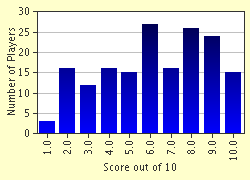Quiz Answer Key and Fun Facts
1. The obvious place to begin would be Saint Saens' famous "Danse Macabre". This piece depicts the appearance of Death in a graveyard playing his violin, while assorted skeletons literally perform a "dance of death". Which of the following is NOT musically depicted in this famous piece?
2. Engelbert Humperdinck's ever popular 1893 opera "Hansel und Gretel" contains an orchestral interlude entitled "The Witch's Ride", which vividly depicts the aerial flight of a bevy of witches on their broomsticks. A similar piece, entitled "The Hut on Fowl's Legs" features in a suite of orchestral pieces (originally composed for piano) entitled "Pictures at an Exhibition". The composer of this work is also famous for the tone-poem "Night on Bald Mountain", which describes a Black Sabbath. Who is he?
3. Trolls of various sizes, a troll king, and some witches threaten to tear apart and kill the hero of a play by Norwegian playwright Henrick Ibsen, in a piece entitled "In the Hall of the Mountain King" from the incidental music written for the play by Edvard Grieg. What is the play?
4. "The March to the Scaffold" and "Dream of a Witches Sabbath" are the rather grim concluding movements of the "Symphonie Fantastique", which details the opium-induced romantic fantasies of a lovelorn poet. Who was the composer of this "fantastic" work?
5. Girl meets ghost. Girl and ghost fall in love. Ghost overhears girl breaking up with erstwhile boyfriend. Ghost leaves girl. Girl jumps off cliff. Ghost's ship sinks. Girl and ghost are reunited (which, now that they're both dead, should work out well). Which of Richard Wagner's opera's features this unlikely love story?
6. Possibly the greatest of Franz Schubert's vast array of German lieder is "Der Erlkonig" ("The Erl-King"), which describes a child menaced by an evil spirit. The text for "Der Erlkonig" is a poem by the same name, written by a great German poet and author; who was he?
7. It has been argued that the opening chords of the overture to this Mozart opera, which reappear in the final act, represents the first genuinely terrifying music ever written. In the opera, the chords announce the appearance of the ghost of a man who is killed in the opera's first scene; the statue atop his tomb comes to life in the final scene and drags his killer to eternal damnation. What is the opera?
8. Written in 1883, "Le Chasseur Maudit" ("The Accursed Huntsman") is a tone poem based on an old German ballad about a huntsman who made the fatal mistake of hunting on a Sunday. As a punishment for this sacrilege, he was condemned to be pursued himself by demons throughout eternity. The composer of "Le Chausser" is best known for his "Symphonic Variations", a symphony in D minor (which is notable for being the first symphony to use the English horn), and the oratorios "Redemption" and "Les Beatitudes". Who is he?
9. For my money, one of the most frightening pieces of music in the classical repertoire is "The Crusaders at Pskov", which describes the brutal German invasion of the Russian village of Pskov. This piece is part of the soundtrack for the film "Alexander Nevsky", by the Russian filmaker Sergei Eisenstein; who was the composer?
10. You might not have thought of Jacques Offenbach's famous "Can-can" in association with Halloween, but its actual title is "Galop Infernal" and it is performed, as the title would seem to indicate, in Hell (actually Hades, since the story is a comic version of a Greek myth). Which Offenbach operetta is it from?
Source: Author
jouen58
This quiz was reviewed by FunTrivia editor
agony before going online.
Any errors found in FunTrivia content are routinely corrected through our feedback system.

